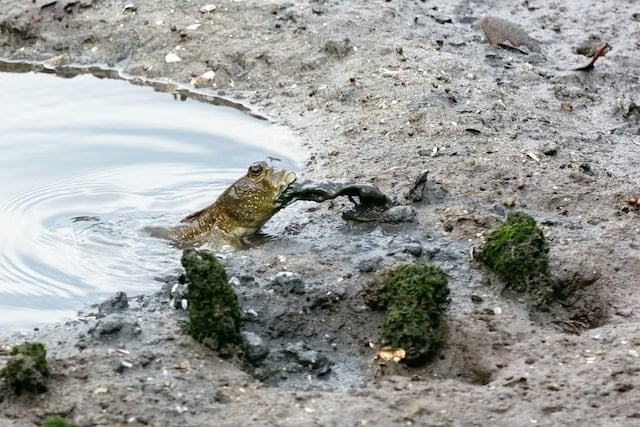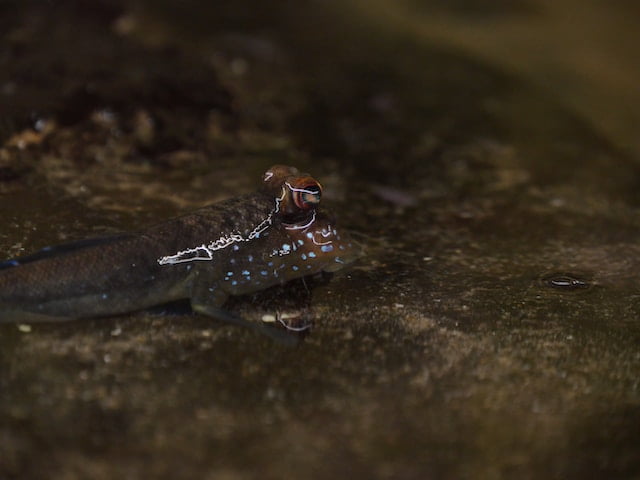We may think that fish belong in the water and can’t survive on land, but there is one species that can do just that – the walking catfish. This unique fish is native to Southeast Asia and is known for its ability to move across land using its pectoral fins.
The walking catfish has a long, slender body and can grow up to 18 inches in length. Its skin is covered in mucus, which helps it stay moist and breathe through its skin when out of water. When on land, the walking catfish uses its pectoral fins to “walk” in a twisting motion, allowing it to move across land in search of food or better living conditions.
While the walking catfish may seem like a fascinating and harmless creature, it has actually become an invasive species in many parts of the world. Its ability to survive out of water and move across land has allowed it to spread rapidly, causing harm to local ecosystems and disrupting native species. Despite this, the walking catfish remains a fascinating example of the incredible adaptability of nature.

Table of Contents
Walking Fish: An Overview
Walking fish are a fascinating group of aquatic animals that have the unique ability to move on land. This remarkable adaptation allows them to explore new environments and access resources that would otherwise be unavailable to them. In this section, we will provide an overview of walking fish, including their unique species.
Unique Species
There are several species of walking fish, each with its own characteristics and adaptations. Some of the most well-known species include:
- Mudskippers: These fish are found in intertidal zones and can move on land using their pectoral fins. They are able to breathe air and can survive out of water for extended periods of time.
- Climbing Perch: This fish is found in Southeast Asia and can use its gills to breathe air. It is able to climb trees and move on land using its strong pectoral fins.
- Lungfish: This fish is found in Africa, South America, and Australia and can breathe air using its specialized lung. It is able to survive in dry conditions by burrowing into the mud and secreting a mucus cocoon around its body.
Each of these species has its own unique adaptations that allow it to move on land and survive in different environments. Studying these adaptations can provide insights into the evolution of terrestrial life and the challenges that animals face when transitioning from water to land.
Overall, walking fish are a fascinating group of animals that have captured the imagination of scientists and the public alike. By studying these unique species, we can gain a better understanding of the natural world and the amazing adaptations that allow animals to survive in even the most challenging environments.
Evolutionary Aspects
Adaptation to Terrestrial Life
As we explore the fascinating world of the walking fish, we must delve into the evolutionary aspects of their adaptation to terrestrial life. The ability to walk on land is a remarkable feat that required significant changes in the fish’s anatomy and behavior.
One of the key adaptations that allowed for terrestrial locomotion is the development of robust fins. The fins of walking fish have evolved into sturdy limbs that can support the weight of the fish on land. Additionally, walking fish have developed a modified gait that allows them to move efficiently on land. They use their pectoral fins to “walk” on the ground, while their pelvic fins are used for balance and stability.
Another critical adaptation is the ability to breathe air. Walking fish have a modified swim bladder that functions as a primitive lung, allowing them to extract oxygen from the air. This adaptation is essential for their survival in oxygen-poor environments and makes it possible for them to spend extended periods out of the water.
Evolutionary Timeline
The evolutionary timeline of walking fish is a subject of ongoing research and debate. Fossil evidence suggests that the first walking fish appeared around 350 million years ago during the Devonian period. These early walking fish had primitive limbs and were likely amphibious, able to move between water and land.
Over time, walking fish continued to evolve and adapt to terrestrial life. Some species, such as the mudskipper, have developed specialized adaptations that allow them to thrive in intertidal zones, where they can survive both in and out of the water.
Overall, the evolution of walking fish is a fascinating example of the adaptability and resilience of life on Earth. By studying these remarkable creatures, we can gain insight into the mechanisms of evolution and the ways in which organisms can adapt to changing environments.
Anatomical Features
Pectoral Fins
We have observed that the walking fish has unique anatomical features that enable it to walk on land. One of these features is its pectoral fins. These fins are strong and muscular, and they are positioned closer to the head than in most other fish species. This positioning allows the fish to use its pectoral fins to support its weight on land and move around.
Respiratory System
Another unique anatomical feature of the walking fish is its respiratory system. Unlike most fish species that rely on gills to extract oxygen from water, the walking fish has a modified respiratory system that allows it to breathe air. It has developed a labyrinth organ, which is a structure in its gills that allows it to extract oxygen from air. This adaptation enables the walking fish to survive in both aquatic and terrestrial environments.
In summary, the walking fish has developed unique anatomical features that allow it to walk on land and breathe air. Its pectoral fins are strong and muscular, and its respiratory system has adapted to extract oxygen from air. These adaptations have allowed the walking fish to thrive in both aquatic and terrestrial environments.
Behavior and Habitat
Land Locomotion
We have observed that the walking fish, also known as the mudskipper, is capable of moving on land. This unique behavior is made possible by its specialized fins, which allow it to crawl and hop on mudflats and mangrove roots. Mudskippers are able to move on land for extended periods of time, and can even climb trees to escape predators.
While mudskippers are primarily adapted to living in water, they are able to breathe air through their skin and the lining of their mouth. This allows them to survive in shallow waters and even out of water for short periods of time. However, they must return to water periodically to keep their gills moist and to regulate their body temperature.
Aquatic to Terrestrial Transition
The transition from aquatic to terrestrial life is a significant challenge for any organism, and mudskippers have evolved a number of adaptations to make this transition possible. Mudskippers are able to breathe air, and their fins have evolved to allow them to move on land. They are also able to tolerate changes in salinity, which allows them to live in both freshwater and saltwater environments.
Mudskippers are typically found in intertidal zones, where they are able to move between water and land as the tide rises and falls. They are also commonly found in mangrove swamps, where they are able to climb up and down the roots of mangrove trees. Mudskippers are able to survive in these environments by feeding on insects, crustaceans, and other small animals that are found in the mud and water.
In conclusion, the mudskipper’s ability to move on land is a remarkable adaptation that has allowed it to survive in both aquatic and terrestrial environments. Its specialized fins and ability to breathe air make it a unique and fascinating species to study.
Scientific Research and Discoveries
Key Studies
We have been studying the walking fish for several years now, and some of the key studies that have helped us understand this unique creature are:
- The Evolution of Terrestrial Locomotion in Fishes: This study looked at the evolutionary history of fish that have developed the ability to move on land. It helped us understand how the walking fish evolved and why they are so unique.
- The Mechanisms of Terrestrial Locomotion in Fishes: This study focused on the specific mechanisms that allow walking fish to move on land. It helped us understand how their fins and body shape have adapted to allow for this movement.
- The Behavioral Ecology of Walking Fish: This study looked at the behavior of walking fish in their natural habitat. It helped us understand how they interact with their environment and how they have adapted to life on land.
Recent Discoveries
In recent years, we have made some exciting discoveries about the walking fish. Some of the most significant ones include:
- The Discovery of a New Species: In 2021, we discovered a new species of walking fish in a remote area of Indonesia. This discovery has helped us understand the diversity of walking fish and how they have evolved in different parts of the world.
- The Role of Vision in Walking Fish Locomotion: Recent studies have shown that walking fish rely heavily on their vision when moving on land. This discovery has helped us understand how their sensory systems have adapted to life on land.
- The Potential Medical Applications of Walking Fish Research: Some researchers are exploring the potential medical applications of walking fish research, particularly in the area of prosthetics. By studying how walking fish move on land, we may be able to develop better prosthetic limbs for humans in the future.
Overall, the scientific research and discoveries related to walking fish have been fascinating and have helped us understand this unique creature in new and exciting ways.
Implications for Future Study
Evolutionary Biology
The discovery of a fish that can walk on land has significant implications for evolutionary biology. The ability to walk on land is a unique adaptation that has only been observed in a few species of fish. This adaptation likely evolved as a response to changing environmental conditions, such as the drying up of shallow waters or the need to move between bodies of water.
Further study is needed to understand the genetic mechanisms underlying this adaptation. Comparative genomics studies could identify the genetic changes that allowed these fish to develop the ability to walk on land. Additionally, studies of the developmental biology of these fish could shed light on the processes that allowed this adaptation to arise.
Climate Change Impact
The discovery of fish that can walk on land also has implications for our understanding of the impact of climate change on aquatic ecosystems. As temperatures rise and water levels decline, aquatic animals may be forced to adapt to new conditions or face extinction. The ability to walk on land may provide fish with a way to survive in changing environments.
Future studies could investigate the potential for other aquatic species to develop similar adaptations in response to climate change. Additionally, researchers could study the impact of walking fish on terrestrial ecosystems. For example, walking fish could potentially invade new habitats and compete with native species for resources.
Overall, the discovery of a fish that can walk on land opens up new avenues of research in evolutionary biology and climate change impacts. Further study is needed to fully understand the implications of this adaptation and its potential impact on aquatic and terrestrial ecosystems.

Frequently Asked Questions
What is the evolutionary history of fish that can walk on land?
Fish that can walk on land have evolved from fish that lived in shallow waters and tidal pools. These fish developed the ability to breathe air and move on land to escape predators or find food. Over time, these adaptations became more pronounced and eventually led to the emergence of fish that can walk on land.
How do fish that can walk on land breathe on land?
Fish that can walk on land have developed different ways of breathing on land. Some species can absorb oxygen through their skin, while others have a modified swim bladder that acts as a lung. Some fish can also use their mouth or gills to take in air.
What adaptations do fish that can walk on land have?
Fish that can walk on land have a variety of adaptations that allow them to survive on land. These adaptations include stronger fins or limbs for walking, a modified swim bladder for breathing, and a protective layer of mucus on their skin to prevent dehydration.
What are some examples of fish that can walk on land?
Some examples of fish that can walk on land include the mudskipper, the walking catfish, and the lungfish. These fish have adapted to different environments and have developed unique ways of moving and breathing on land.
Can fish that walk on land survive solely on land?
While fish that can walk on land are adapted to survive on land, they still require water to live. These fish need to return to water periodically to breathe and regulate their body temperature. However, some species can survive for extended periods of time out of water, especially during periods of drought.
How do fish that can walk on land move on land?
Fish that can walk on land use a variety of methods to move on land. Some species use their fins or limbs to walk or crawl, while others use a jumping or hopping motion. Some fish can even glide through the air for short distances.





